Director’s Introduction
Hilton Lewis, Director, WMKO
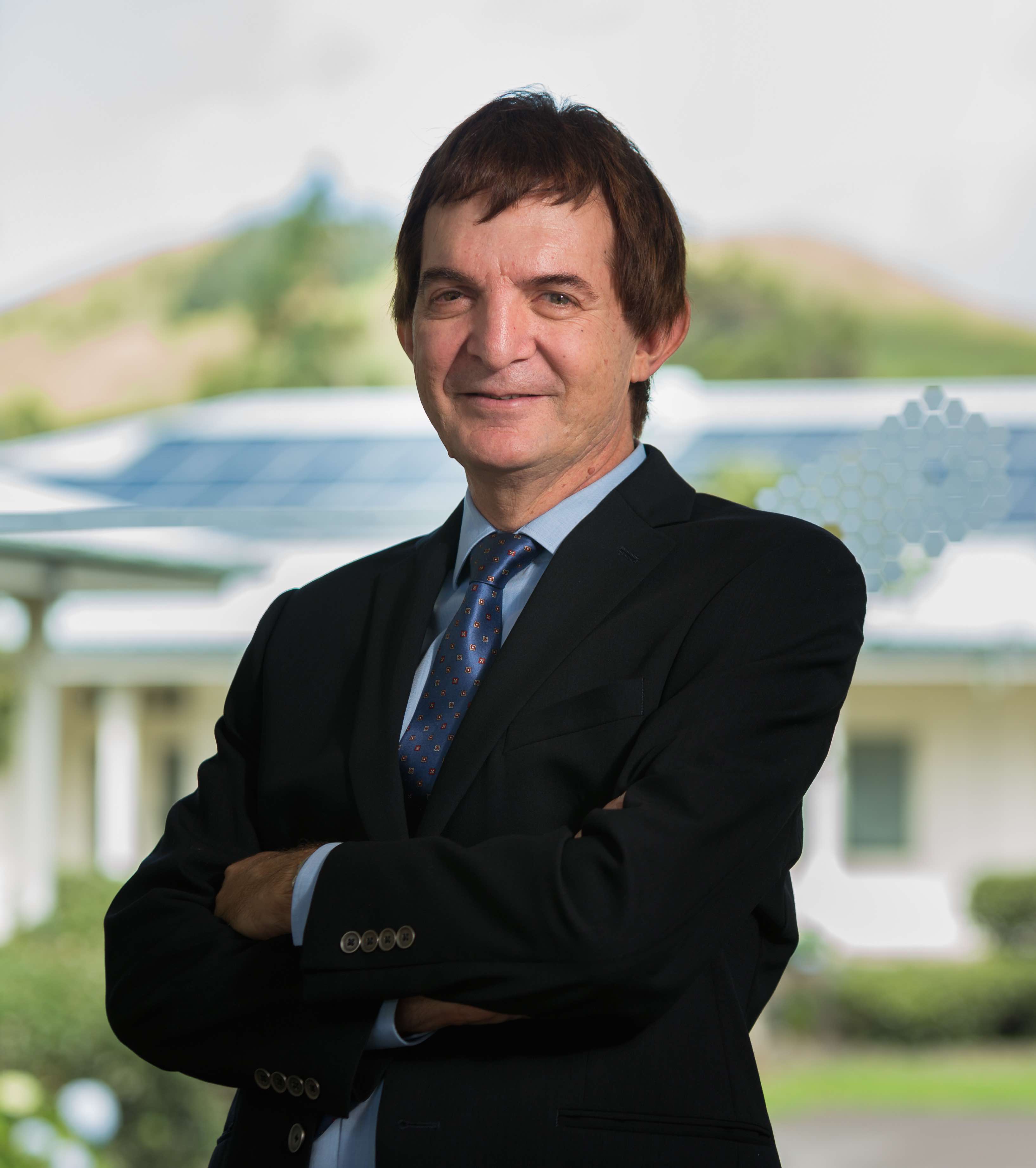 Welcome to the summer 2016 edition of the Keck Observers’ Newsletter. Here you will find updates on activities that directly affect our observers. And we have plenty of positive news to report. A very important step, with long-term implications is the completion of our scientific strategic plan. You can read about the process and outcomes in this newsletter. Of particular note was the widespread engagement with members of our community in the process to develop the plan – an approach that is critical to ensuring that the observatory will provide the capabilities that serve the scientific interests of its users. Another important development, and one that foreshadows the arrival next year of the deployable tertiary for Keck 1, is the adoption of new policies, procedures and tools to facilitate time domain astronomy at the Keck Observatory. This is an important step forward to ensure that our community can fully participate in the exciting developments in this arena. The new policies are in place for a two-year trial period, after which we will evaluate and modify them if necessary.
Welcome to the summer 2016 edition of the Keck Observers’ Newsletter. Here you will find updates on activities that directly affect our observers. And we have plenty of positive news to report. A very important step, with long-term implications is the completion of our scientific strategic plan. You can read about the process and outcomes in this newsletter. Of particular note was the widespread engagement with members of our community in the process to develop the plan – an approach that is critical to ensuring that the observatory will provide the capabilities that serve the scientific interests of its users. Another important development, and one that foreshadows the arrival next year of the deployable tertiary for Keck 1, is the adoption of new policies, procedures and tools to facilitate time domain astronomy at the Keck Observatory. This is an important step forward to ensure that our community can fully participate in the exciting developments in this arena. The new policies are in place for a two-year trial period, after which we will evaluate and modify them if necessary.
Many new and exciting capabilities are in the pipeline. These range from the imminent full release of the upgraded Telescope Control System (already in science use for a subset of our instrumentation on Keck 2), to the completion of the Keck Cosmic Web Imager, to the commissioning of the deployable tertiary for Keck 1. And there are a host of other capabilities in the pipeline, or close to completion. We will report on these capabilities as they become available for science in future editions of this newsletter.
I strongly encourage you to attend the Keck Science Meeting on September 15-16 this year at Caltech, to learn more of our plans and status, and to discover first hand the exciting science being carried out at the observatory. I also encourage you to attend the Keck/JWST workshop, also at Cahill, Caltech on September 12-13, an opportunity for the Keck community to discuss the best ways to participate in JWST early release science. You can find details of both these events at http://www.astro.caltech.edu/ksm2016.
Now please enjoy reading more about the remarkable work being performed to keep the W. M. Keck Observatory at the forefront of research.
A hui hou kākou – Hilton Lewis, Observatory Director ✶
Keck Observatory Strategic Plan
Anne Kinney, Chief Scientist, WMKO
The Keck Observatory has a glorious history of transformative discoveries, instrumental advances, and education for young scientists since the start of operations in 1993. Our strategic plan is the vision for the next 5 years to ensure the continuation of this great tradition during a period of rapid change.
The guiding principles for the plan were to push the limits in faint object spectroscopy, to lead AO imaging and spectroscopy with new capabilities, to prepare for increasing opportunities in Time Domain Astronomy, to lead the ground based preparation as well as follow-up for NASA’s flagship missions, and finally, to continue Keck’s emphasis on highly efficient operations.
Approximately 60 scientists participated in the Keck Scientific Strategic Plan from the entire Keck community. The Keck community was invited in September 2015, to volunteer to serve on Task Groups focused on various aspects of the future environment in which astronomy would be pursued.
From the volunteers, Task Groups were formed to focus on:
- Characterizing Other Worlds with the Keck Telescopes,
- Keck in the JWST Era and Beyond,
- Optimizing the Joint Scientific Return of the Keck, WFIRST, and Euclid,
- Keck in the Era of TMT,
- Strategic Recommendations for Keck observatory; Time Domain Astronomy,
- Enhancing the Keck/Subaru partnership into the TMT Era, and finally
- Evolution of Adaptive Optics at Keck.
| Instruments | Notional First Light | Support |
|---|---|---|
| Keck Planet Finder (KPF) | 2020 | Exo-planets, JWST,WFIRST,TMT |
| Keck All Sky Precision AO (KAPA) | 2019 | Exo-planets, JWST,TMT |
| Upgrades, Enhances Capabilities | ||
| NIRSPEC PRV | 2018 | Exo-planets, Push limits of FOS |
| Keck Observatory Archive (KOA), Data Reduction Pipeline (DRP) | Ongoing | Maximize scientific impact, Efficiency of operations. |
| AO PSF Facility | 2018 | Maximize scientific impact |
| Design Studies | ||
| Highly multiplexed, highly sensitive spectroscopy, (e.g. doubling of DEIMOS FoV, detector upgrades, grating upgrades, etc.) | WFIRST, Euclid, TMT, Push limits of FOS. | |
| High Contrast AO (HCAO) | Exo-planets, JWST, Subaru synergy, Maximize science impact. | |
| Next generation instruments (e.g. Super NIRSPEC, Dream Machine, larger format IFU for AO, wide field UV imager) | Exo-planets, JWST, TMT, AO | |
| GLAO, performance gains, cost of implementation on one or both telescopes, investigate performance of current suite of MOS’s with GLAO, etc. | JWST, WFIRST, Euclid, TMT Improve efficiency of ops, maximize scientific impact. | |
| Deployable tertiaries (mirror and/or dichroic) | JWST, WFIRST, TDA, Efficiency of operations, maximize scientific impact. |
The W. M. Keck Observatory Scientific Strategic Plan can be found here. ✶
DEIMOS service mission
Carlos Alvarez, Support Astronomer, WMKO
Marc Kassis, Support Astronomer, WMKO
Steve Milner, Instrument Engineer, WMKO
Dwight Chan, Instrument Engineer, WMKO
Jim Ward, Principal Laboratory Mechanical, UCO/Lick
Ean James, Mechanical Engineer, WMKO
Adam Vandenberg, CAD designer, WMKO
Despite initial efforts to improve the reliability of the DEIMOS grating system during a service mission in January 2015 (see a previous Newsletter), operational performance of the instrument remained problematic. To address these issues, this year we executed “Parte Dos”: a second service mission that focused on the flywheel mechanism in the grating subsystem that controls the wavelength positioning. Parte Dos was completed during two weeks of scheduled down time in March 2016, and observers are now benefitting from this work completed by WMKO and Lick staff. The grating system performance is as good as it was soon after commissioning DEIMOS over a decade ago.
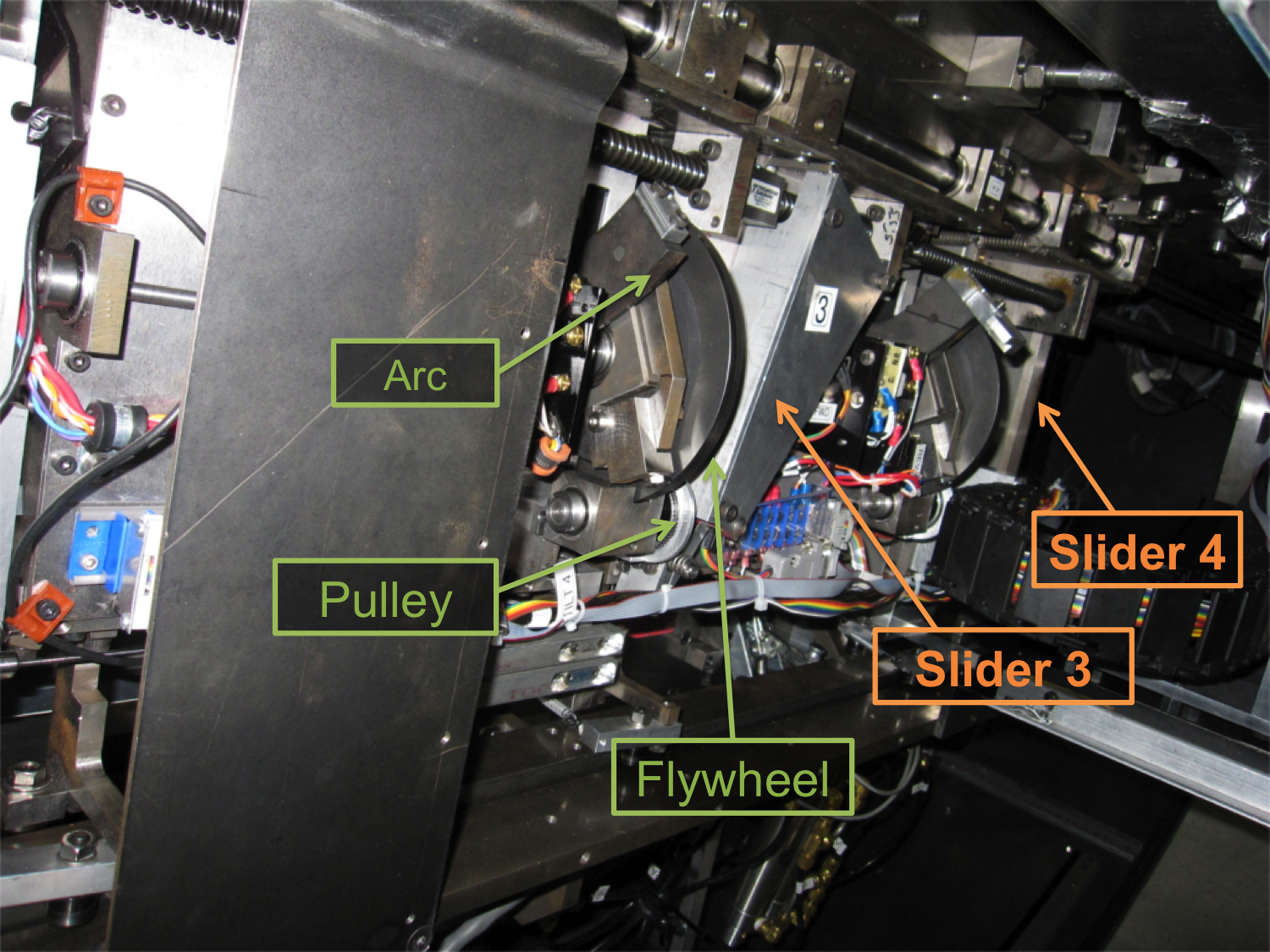
|
| Figure 1. Grating slider assembly in DEIMOS. Some of the components of the grating tilt mechanism in slider 3 are labeled in green. |
Figure 1 labels the parts that were serviced on the grating subsystem. Observers familiar with DEIMOS will notice sliders 3 and 4 are labeled, and these sliders are the main holders of the gratings that are reconfigured daily by the summit staff. The arc, pulley and flywheel are intimately associated with the grating tilt mechanism responsible for setting the central wavelength. In the past, the flywheel and arc could slip resulting in poor wavelength positioning. The pulley system has the belt which either broke or sometimes slipped off the pulleys resulting in an inoperable grating tilt mechanism for the night.
The main work done on the system consisted of the following tasks:
- Installed new arcs that should reduce slippage and wear
- Installed rounder and more concentric flywheels to reduce wear and tear
- Optimized the concentricity of the flywheel-shaft assembly for improved wavelength repeatability
- Glued with Loctite 620 bearings holding the flywheel shaft to reduce slippage
- Replaced tension springs that will improve grating positioning
- Cleaned and polished parts in the clamping system to reduce frictions that resulted in poor wavelength positioning
- Installed new pulleys and a wider belt to prevent belts breaking or slipping off the pulleys
- Modified the grating pin to reduce flexure at all rotator angles
After addressing the points above, WMKO staff fine-tuned the clamping mechanism so that both gratings will clamp at all rotator angles. This means that the Flexure Compensation System (FCS) will always be within the correction limits no matter what rotator angle the grating is clamped at. Thus, DEIMOS regains some efficiency because observers no longer need to run select_slider when changing between the two available DEIMOS gratings.
Figure 2 shows some of the wear on the flywheel shaft replaced in 2015 caused by friction with the arc. The inset shows the contact surface in the old arc, which has sharp edges, and the new re-machined arc featuring beveled edges to reduce the wear on the flywheel shaft. We found metallic debris due to wear in the contact surfaces between the pulley shaft and the flywheel, as well as between the flywheel shaft and the arc. These were all parts that were replaced in 2015.
We believe that a combination of irregular wear and the presence of debris were producing differential friction between the metallic surfaces. This was causing irregular stretching in the drive belt to the point of breakage. The other likely consequence of the differential friction was slippage, which yielded drifts in the grating tilt. When these drifts were large, the FCS could not cope with the required correction and it was necessary to intervene manually, through the fix FCS script, to steer the FCS back to its normal operation range.
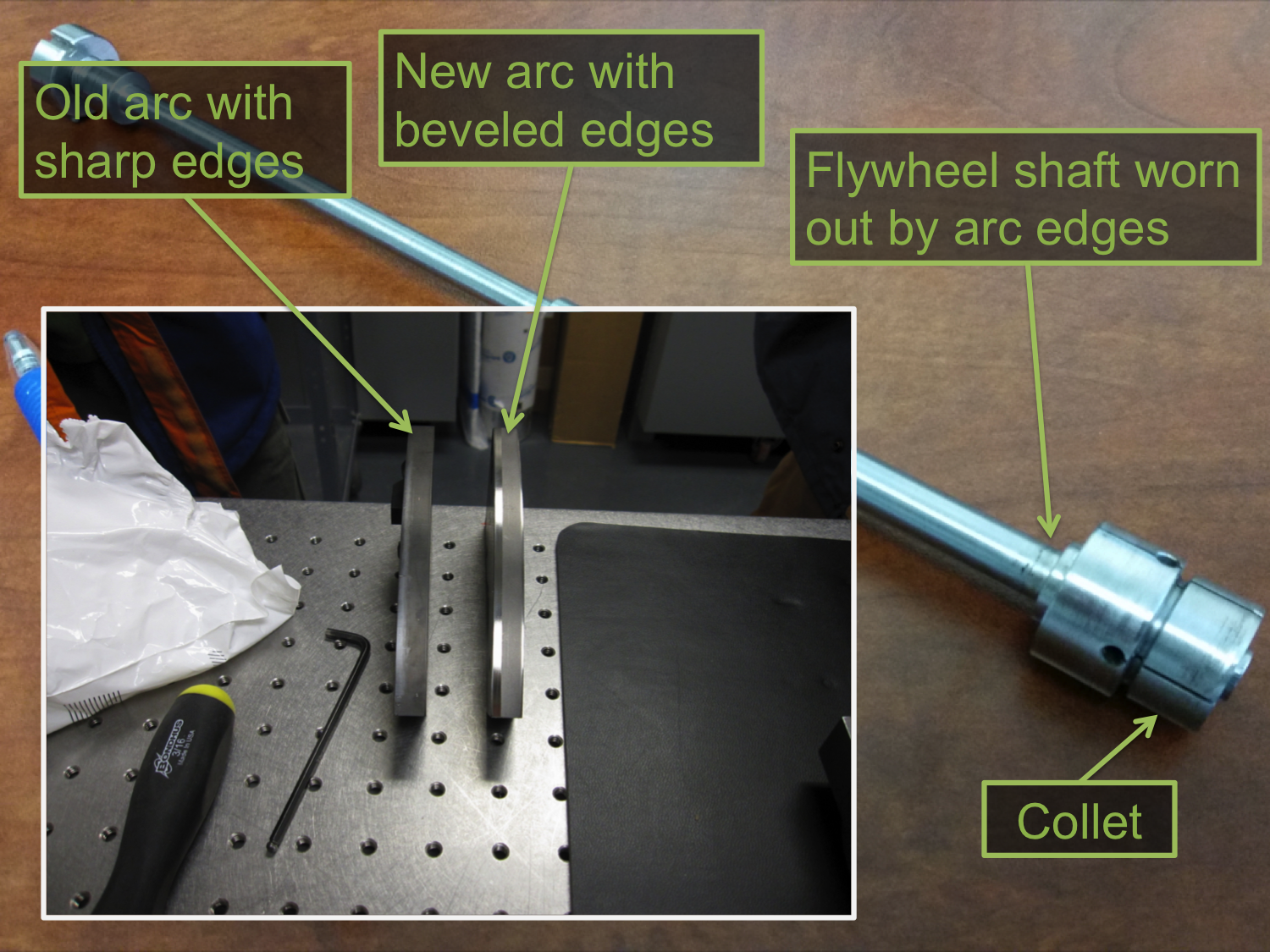
|
| Figure 2. Flywheel shaft wear out due to friction with tilt arc. Inset shows the old arc with sharp edges and the new arc mechanized with beveled edges to prevent wearing out the flywheel shaft. |
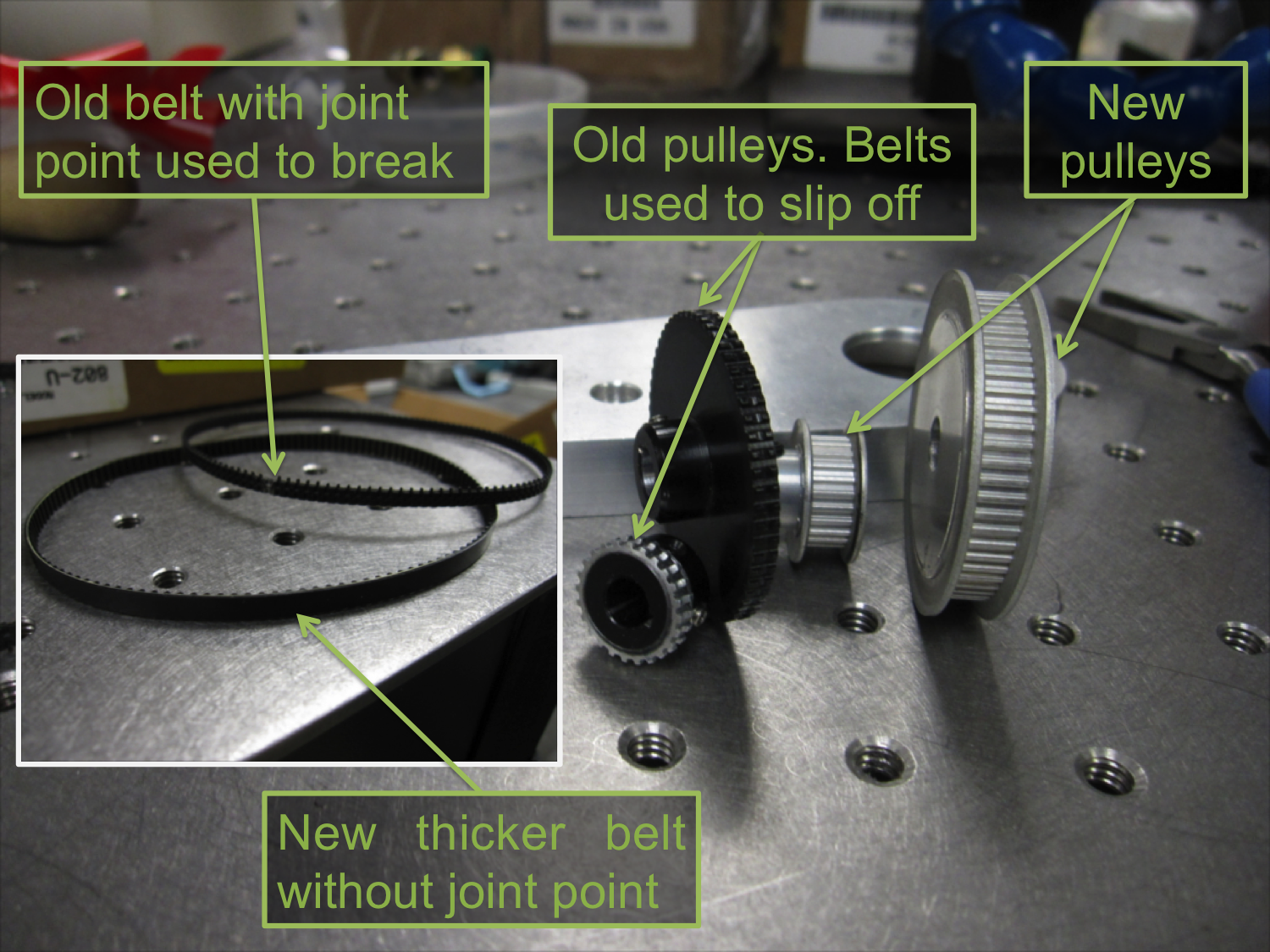
|
| Figure 3. Comparison between the old and new pulleys for the grating tilt system. The inset shows a comparison between the old and new drive belts connecting both pulleys. |
In summary, as a result of the service mission:
- The grating tilt system is more robust to belt breaks.
- Belts are extremely unlikely to slip off the pulleys.
- The clamping performance and flexure properties of the grating system improved considerably.
- No time was lost to mechnaical failurs of the grating subsystem since the end of the mission.
We expect that for the foreseeable future, the grating subsystem will continue to operate more reliably. Many thanks are extended to Dave Cowley and Jim Ward at Lick, WMKO staff who relentlessly pursued improvements, and to our observing community who experienced issues in the past two years but were patient with the improvement process. ✶
New Remote Observing Facility Coming to the DC Area
Greg Doppmann, Support Astronomer, WMKO
At long last, a remote observing facility for the Keck Observatory is coming soon to the Baltimore/Washington area. Finally, astronomers working in the area – such as at NASA Goddard, Space Telescope, Johns Hopkins U., Naval Research Lab, Univ. of MD, and Carnegie Institute - will simply just hop on I-95 and get off in Columbia, MD, conveniently midway between Washington and Baltimore.
The Universities Space Research Association (USRA) is a nonprofit research corporation committed to supporting research in astrophysics, among other areas of science. Providing a Keck remote observing site for DC area astronomers is well aligned with USRA's mission. Remote observers there will control Keck instruments via virtual network computing (VNC) screens, as if they were 5,000 miles west at Keck HQ in Waimea on the Big Island.
The observing facility at USRA will be located in a new building on campus, which is currently under construction. The remote site is expected to be available this autumn for use by astronomers who have scheduled telescope time at Keck. The facility will have an ISDN line in place as a failsafe in case of any network outages between the summit of Maunakea and USRA. Fulfilling this requirement adds USRA to the Keck family of about a dozen “mainland only” sites across the country. We will send out a formal announcement to the user community once remote observing is available at USRA.
We are happy to welcome USRA to the Keck remote observing community! ✶
New Door Codes at Keck HQ for Visiting Astronomers
Greg Doppmann, Support Astronomer, WMKO
A new security policy to ensure safety for astronomers visiting Keck HQ is being implemented starting on August 1st, 2016. The new policy will involve periodic changes to the door codes for visitors accessing the observing wing (i.e., remote Ops), and the VSQ rooms and commons. Note that access to these locations using the previous codes will not be possible after July 31, 2016.
The current door code to the observing wing at HQ will be provided in an automated email to each observer once a VSQ room has been requested in their name via the online form: http://www2.keck.hawaii.edu/inst/common/VSQ.html. For those not staying in the VSQ and observing at HQ will still need to fill out this form in order to be added to the telescope schedule and to receive their access code.
VSQ reservations for all observing members coming to Keck HQ are normally made about one month prior to the observing run. Once a reservation has been requested online, the observer will be sent an email confirmation within 1-2 business days from vsq@keck.hawaii.edu that will have the current door code along with other pertinent arrival information.
Upon arrival into the observing wing (i.e., Kohala Wing), each observer will find a sealed envelope with their name on it, located in the hallway just outside the remote observing rooms. The observer’s VSQ room assignment, door code access information, along with other relevant information will be found inside the envelope.
If an observer has NOT received a confirmation email from vsq@keck.hawaii.edu containing the current door code, it will be important for them to contact their support astronomer before their arrival to obtain the current door code. ✶
Mahalo Hien Tran
Jeff Mader, KOA Project Manager and Software Engineer, WMKO
This past December, Keck Observatory was awarded the 2015 NASA Group Achievement Award for pioneering the Keck Observatory Archive (KOA). Initially a project to archive NASA-acquired HIRES data, KOA quickly grew to archive not only all HIRES data, but all Keck data taken with all ten instruments over the lifetime of Keck. Data once taken to help answer a particular scientific question can now be used for other scientific needs. The success of KOA is shown in the growth of the number of published papers which use data from the archive:
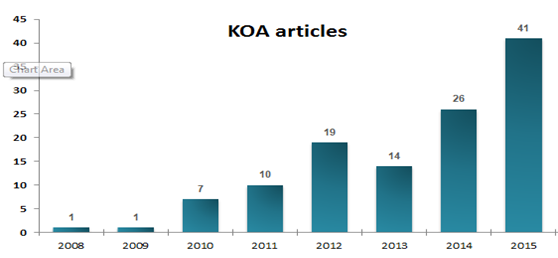
|
| Figure 4. Refereed articles based on KOA data. |
It’s important to work with those that you can count on. Thank you, Hien, for being such a dedicated, hardworking and important part of the KOA team. Your dedication and desire have helped lead KOA to success.
We wish Hien the best in his new adventure. His fingerprints will always on the foundation of the Keck Observatory Archive. ✶
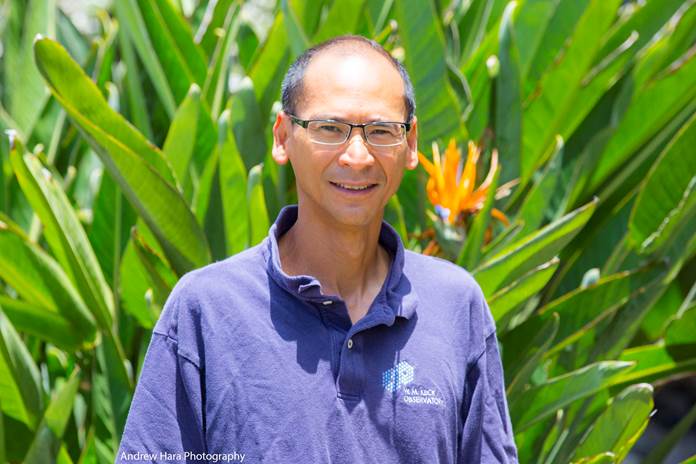
|
OSIRIS Spectrograph Upgrade and Updates on the Data Reduction Pipeline
Jim Lyke, Support Astronomer, WMKO
The SPEC detector in OSIRIS has been upgraded to a H2RG. It was returned to service in April and has been used on-sky for science on 29 nights. We are still working on new calibration scans in all modes, but please see http://tkserver.keck.hawaii.edu/osiris/ for the latest rectification matrices.
Any change to OSIRIS requires updates to its DRP. With the new SPEC detector, we also have a new distribution method for the OSIRIS DRP: github (https://github.com/Keck-DataReductionPipelines/OsirisDRP/releases). Among the changes:
* Updates to the code in order to run the pipeline for the new detector.
* For data taken in 2016 onward, it is no longer necessary to run the following modules:
* Remove Cross Talk.
* Glitch Identification.
* It is fine to keep them in the DRF XML, these modules will automatically not run on the new data.
* Installation has now been simplified (see README for instructions). Bash scripts have been included for those who would like to use bash shell.
* Test framework is now available to run tests of the pipeline (requires pytest module in python, see README in ''tests'' directory).
* WCS bugs have been fixed.
* This beta release has not been tested extensively on pre-detector upgrade data.
Additional information and detailed installation instructions can be found at the OSIRIS Toolbox (https://www2.keck.hawaii.edu/inst/osiris/tools/). If you have issues, we ask that you submit them to the built-in github issue tracker (https://github.com/Keck-DataReductionPipelines/OsirisDRP/issues).
We are aware of flux mis-assignment errors and a sampling issue that looks like fringing for emission line sources. These appear to be DRP-induced, so the raw data are good. There is a large, community-led effort working on these issues and we hope to have updates in 2017. We thank the community for all its effort in improving OSIRIS! ✶
Keck Telescope Image Size vs. DIMM seeing at Mauna Kea
Kuochou Tai, Optical Engineer, WMKO
Over the years, the Keck observing assistants have been faithfully recording telescope image spot size nightly, upon completing the telescope focus procedure. The procedure is carried out about twice per night at the beginning and around the middle of the night for the two telescopes. The image size data serve as indicators for the optics quality and also are expected to reflect the seeing condition at Maunakea. Here we report that the distribution of image size (without adaptive optics) has been stable over the years, as exemplified in the two histograms below: top for the 15.5 year lapse from 2000-2016, and the bottom for the most recent 1.5 year lapse. The overall shapes and median values of the two plots are similar. The data comes from two telescopes, all instruments, elevations and environmental conditions (temperature, humidity, wind speed).
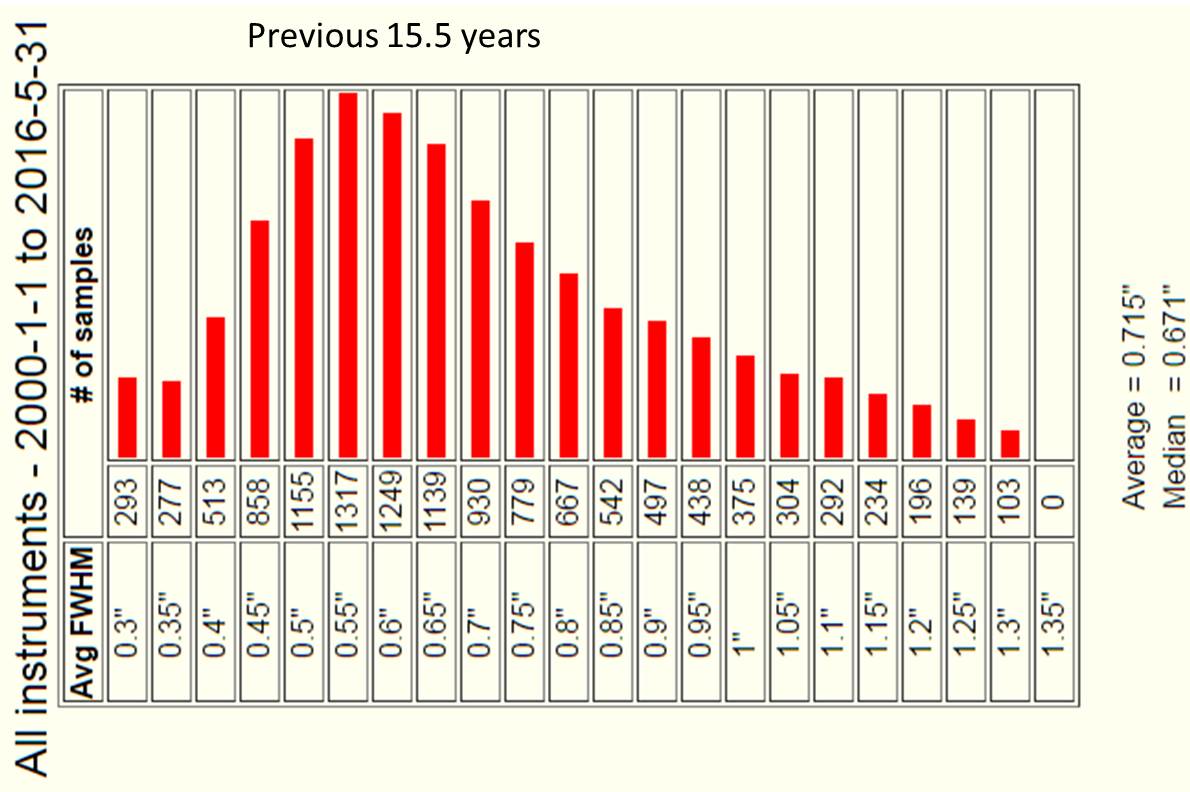
|
| Figure 6. Image size statistics for the previous 15.5 years |
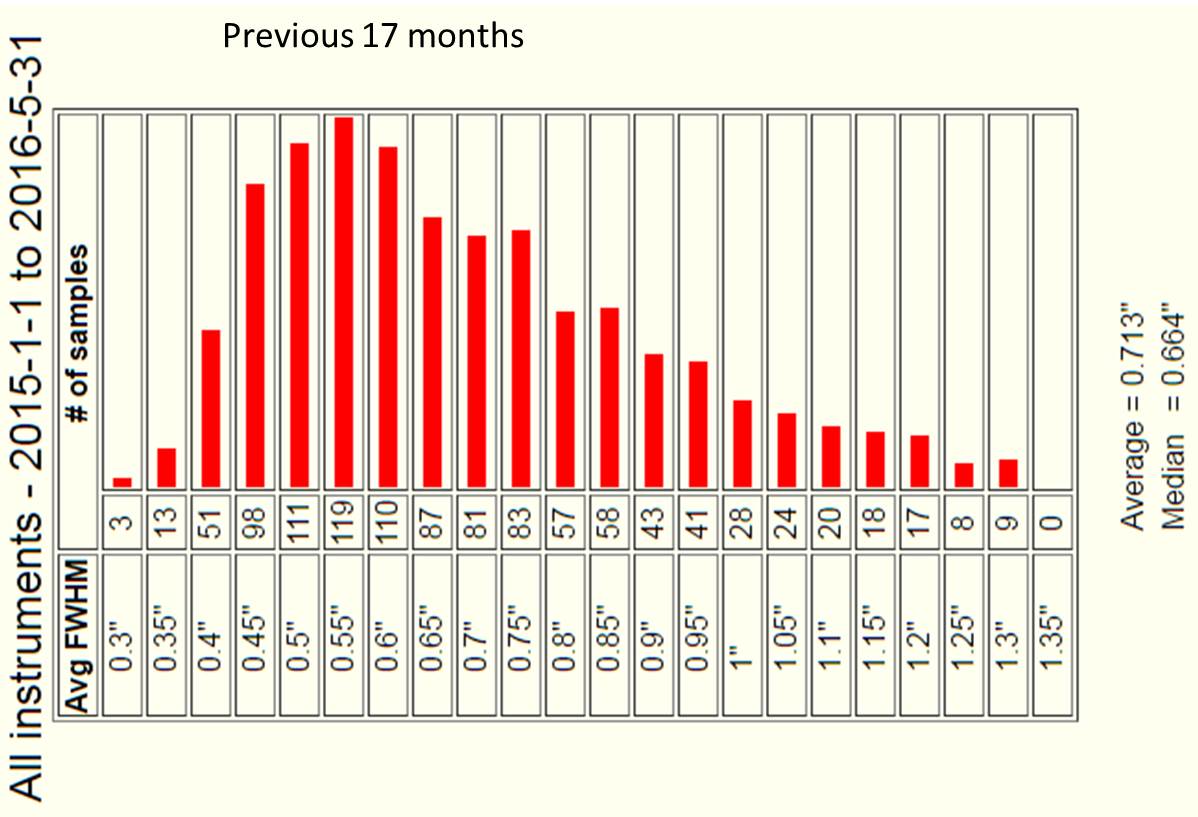
|
| Figure 7. Image size statistics for the previous 17 months |
Finite image spot size comes from a combination of the atmospheric seeing and the aberrations present in the telescope and instrument optics. It is useful to compare telescope spot size with independently measured DIMM (differential image motion monitor) seeing. On the summit of Maunakea, DIMM seeing and its statistics are made available by CFHT (mkwc.ifa.hawaii.edu/current/seeing/analysis/). Seeing is usually reported at zenith angle and at 500 nm wavelength. Seeing at other elevations and wavelengths can be estimated based on a seeing model which scales with -1/5 power of wavelength and 0.6 power of air mass. The Keck telescope image size closely follows the CFHT DIMM seeing and seeing model, as shown in the figure below, which plots image median image spot FWHM from four Keck instruments and the CFHT seeing model as a function of wavelength for zenith, 60, 45 and 30 degree elevation.

|
| Figure 8. Keck median spot size and CFHT median DIMM seeing. ✶ |
Keck Introducing Scheduling Flexibility to Better Accommodate Time Domain Astronomy Programs
Marc Kassis, Support Astronomer, WMKO
Randy Campbell, Observing Support Manager, WMKO
The Keck Strategic Plan identified the need for improved scheduling flexibility to accommodate programs that require regular cadence observations and for programs that require rapid response observations of transient objects, the frequency of which will likely increase as several large survey programs reach first light. The Plan also recognizes the high value placed on “classically scheduled” observing and thus any new strategies are required to keep the vast majority of whole night programs in place. During the past two semesters, Keck, UC, and Caltech participated in a pilot program to accommodate Target of Opportunity, ToO, programs that were permitted to interrupt the participating institutions. The program is now being expanded to include UH, and NASA. The policies, procedures, and software are undergoing changes to better support both Cadence and ToO observations.
For clarification, cadence programs are defined as requiring repetitive short (<1 night) observations during a semester. The new policy provides the flexibility to schedule a cadence program on a participating partner night to better meet the observing date constraints for those programs. Cadence programs and classically scheduled nights will be folded into the telescope schedule at the beginning of each observing semester by WMKO. There are two distinct categories of Cadence observations:
- Partial night scheduling: as small as ¼ nights may be requested and WMKO will schedule these using regular constraints of classically scheduled programs. To accommodate these requests a classically scheduled program requesting 2 nights may be allocated 1 night and 2 half nights so that a 2x½ night cadence observation program may fit in the schedule. A restriction of 10% of the allocated full nights may be redistributed in this manner.
- Snapshot observations: for cadence programs that require one hour or less, WMKO will schedule these cadence observations on classically scheduled nights but will not always be able to preserve the classical programs requested time. Thus, a classical program that is requesting 2 nights may be allocated in the scheduling process 1.9 nights so that a snapshot observation may be acquired. These cadence observations should be requested for either the beginning or end of night to minimize overheads, but special accommodation may be made if the science case is compelling. WMKO will work directly with the TACs when reducing awarded time to accommodate snapshots, and snapshots will not be scheduled on nights where a classical program was awarded one night or less.
Observers may also propose ToO programs which are essentially unscheduled snapshot observations limited to up to one hour and only once per night. These programs may not interrupt programs that are scheduled for ½ night or less. UC, Caltech, UH, and NASA researchers can propose to their respective TACs for cross-institutional ToO (“Partnership ToO”) observations on Keck 1 and Keck 2. Cross-institutional ToO requests may not interrupt non-participating partners under the current guidelines.
The partners have agreed to a two year trial period after which the time domain astronomy policies will be re-evaluated. We are anticipating small modifications to the policies after the Keck 1 deployable tertiary has first light in 2017A. For a complete description of the adopted policies for Time Domain Astronomy please review the Cadence and ToO guidelines that are also listed on the ToO Policy and Observing Procedure pages.
The WMKO scheduling team will do its utmost best to schedule all of the approved ToO programs; however, it may not be possible to schedule everything the TACs approve. To help us better accommodate TDA requests, we are developing new software tools that will improve flexibility in scheduling. We are collaborating with NASA schedulers who have developed similar scheduling tools, and we are working with the TAC schedulers to build in views and functions that will improve information flow during the scheduling process. These tools include updates to:
- WMKO proposal cover sheet
- Scheduling tools for the WMKO scheduling team
- Tools for the partner TAC schedulers to communicate the awarded time and the schedule preferences
- New interfaces for managing ToO and cadence allocations and processing feedback from observers
- Updates to real-time observing software
To this end, observers proposing for time in the 2017A semester will be using an updated proposal cover sheet form. The new form has a cleaner look and feel with most of the instrument and scheduling information available by clicking on the dropdown links at the top of the form. The form has the ability to increase table sizes as needed, and there are three program types:
- Classical – a program requesting nights that are flexible in scheduling
- Cadence- - a program with specific dates separated by intervals
- ToO – a program that requires irregular and response observations to transient events.
Selecting one of the three program types will reveal three distinct views. For programs that formerly included both classical and ToO observations under one umbrella cover sheet submission, you will now need to submit two cover sheets so that WMKO may track ToO usage separately and the TACs can more easily distinguish the ToO proposal demands.
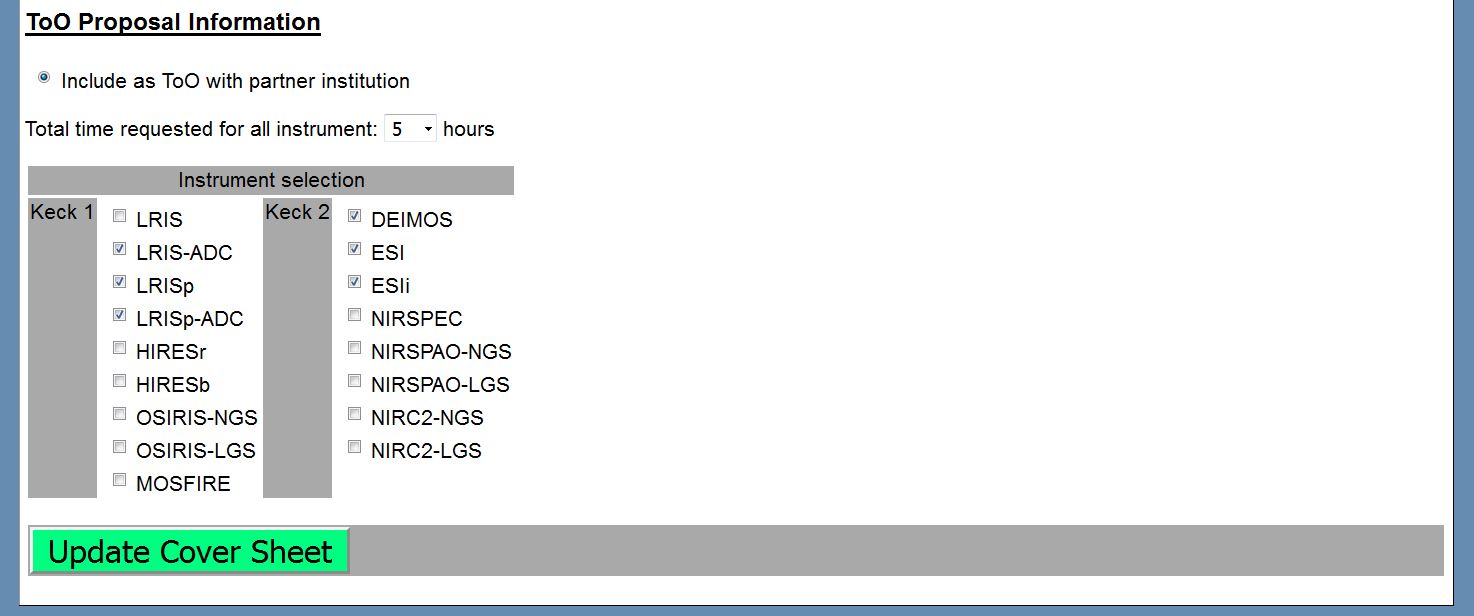
|
| Figure 9. ToO proposal type view. This view provides an area for instrument selection, total time request, and a flag for the cross institutional interrupt agreement. |
Observers will also notice changes with the Program Interface GUI (PIG) and the Program Interface GUI Summary TAC Index (PIGSTI). These two tools are updated at the beginning of a semester with the ToO programs that were approved by the partner TACs. Currently, these two tools should be used to assess whether an interrupt request is an approved ToO program. The PIG will list all the available ToO programs that are approved for the current instrument on sky and dynamically updated each night. On split nights with instrument changes, it may be necessary to review the PIGSTI to ascertain whether a ToO request is approved for the second half of the night. Future TDA tools will include an automated ToO triggering form that will notify the on sky observers and support staff, so stay tuned. ✶
2016 Release of the MOSFIRE Data Reduction Pipeline
Josh Walawender, Support Astronomer, WMKO
Luca Rizzi, Support Astronomer, WMKO
We are happy to announce the 2016 release of the MOSFIRE Data Reduction Pipeline, scheduled to be officially released immediately after the 2016 Keck Science Meeting.
The 2016 release focuses primarily on "under the hood" improvements to make upgrades and maintenance of the software easier, but we have added two new features.
A key driver of the updates in the 2016 release of the MOSFIRE DRP is the deprecation of the Ureka installer for astronomy software. Ureka had previously been the recommended Python and IRAF installation for use with the MOSFIRE DRP. One of the motivations for Ureka's deprecation is incompatibilities between IRAF and "modern operating systems" (see __Why is this happening?__ discussion on the Ureka web page). As a result, we have removed use of IRAF/PyRAF in the MOSFIRE DRP and replaced those tasks with Python-only implementations. Specifically, IRAF's `geoxytran`, `imcombine`, and `imarith` tasks have been replaced with Python equivalents.
The MOSFIRE DRP should now run on systems which have a Python 2.7 installation and which have the required Python packages. A typical Python installation will have most or all of the dependencies with the possible exceptions of numpy, scipy, astropy, and ccdproc which can be installed using standard Python tools such as `pip` or `conda`. We recommend use of the Anaconda Python distribution and will provide instructions for installation for those using the `conda` installer tool. The DRP has been tested on Mac OS X El Capitan (10.11.5) and on linux (RHELv7.1 and Ubuntu 16.04).
The slit tracing algorithm has been improved to adapt to challenging cases such as very low illumination in the Y band, using a simple algorithm to determine the threshold for detecting a slit edge rather than using a set value.
The User's Manual has been updated and will now be built and maintained as a web page (to be released concurrently with the 2016 release of the DRP software).
A routine for optimal spectral extraction (see Horne 1986) has been added to the DRP and the user can now optionally output a 1D FITS file with a wavelength calibrated spectrum. This spectral extraction routine is not intended for science, but is provided as a quick look tool.
Please note that the changes described here are planned. The final 2016 release may differ slightly from what is discussed above. For the latest information, please see the discussions on github or email mosfiredrp@gmail.com. ✶
Keck II Next Generation Laser
Jason Chin, Project Manager, WMKO
The Keck II Laser Guide Star (LGS) Adaptive Optics System (AO) was upgraded from the Lawrence Livermore dye laser to a TOPTICA/MPBC Raman-Fiber Amplification laser and completed its first light on December 1, 2015. After being off line for 6 months, the Keck II LGSAO system returned to science operations on April 16, 2016. The new laser has the advantage of using the latest diode pump laser technology, Raman amplification, and a second harmonic generator to produce a 589.189 nm beam. The combination of the new laser and changes to the center launch system vastly improves the performance, operability, and reliability of the system. The laser is able to produce a highly stable laser beam with the required 20 watts of power (<1% peak to peak), wavelength (± 40 MHz), and mode quality (M2 < 1.1). The beam’s linear polarization (>100:1 extinction ratio) and continuous wave format, along with optical repumping (D2b), are designed to improve the sodium atom coupling efficiency over previously operated sodium-wavelength lasers. The efficiency and operability of the new laser has also been improved by reducing its footprint, required input power and cooling, and the manpower to operate and maintain it. Its quick remote startup in < 5 minutes makes it ideal for time domain astronomy. As an added bonus, the completed infrastructure modifications can easily support two additional lasers in the future.
The on-sky return from the new laser has a LGS equivalent R magnitude of 7.5 ± 0.2 as compared to 10.7 ± 0.4 for the dye laser center launch system with the telescope at zenith. The new laser’s R magnitude does vary between 7th and 9th magnitude based on the pointing direction of the laser. This variability is due to the effectiveness of the D2b sodium line repumping which is impacted by the laser beam's alignment to the earth’s magnetic field. The model’s optimal pointing direction is 195º azimuth and 30º zenith angle, not too far off of the galactic center observations. The FWHM spot size of 1.6" is not too different from the previous dye laser center launch beam as well as the Keck I’s center launch beam. In terms of science, the new laser and launch system reduces the measurement and bandwidth errors. With the added return, the wavefront sensor/controller is now operating at 1 kHz instead of 400Hz. The Strehl ratio at Bracket gamma, under excellent seeing conditions, nearly reaches 65% with a FWHM near 50 mas for on-axis tip/tilt stars. Laser return is no longer a major limiting factor in the performance with sufficient laser return to operate the wavefront sensor/controller at even higher speeds. This is an area the development team is looking further into.
Operationally, the efficiency of the laser and its pointing has been greatly improved. There is significantly less requirement for manual alignments of the laser by the operators. Besides the very quick turn-on time, the new laser consumes 1/50th of the electrical power required for the dye laser impacting the observatory's monthly power bills. Manpower requirement for startup and maintenance has been significantly reduced. The laser itself has redundancy built-in in case of diode failure in the middle of an observing run. The project is currently working on the purchase of spare line replaceable units to reduce down time when there are failures. ✶
Back Issues
Please see the Keck Observers’ Newsletter Archive.

